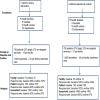Effect of Paying for Performance on Utilisation, Quality, and User Costs of Health Services in Tanzania: A Controlled Before and After Study
- PMID: 26317510
- PMCID: PMC4552688
- DOI: 10.1371/journal.pone.0135013
Effect of Paying for Performance on Utilisation, Quality, and User Costs of Health Services in Tanzania: A Controlled Before and After Study
Abstract
Background: Despite widespread implementation across Africa, there is limited evidence of the effect of payment for performance (P4P) schemes in low income countries on the coverage of quality services and affordability, consistent with universal health coverage objectives. We examined the effect of a government P4P scheme on utilisation, quality, and user costs of health services in Tanzania.
Methods: We evaluated the effects of a P4P scheme on utilisation of all maternal and child immunization services targeted by the scheme, and non-targeted general outpatient service use. We also evaluated effects on patient satisfaction with care and clinical content of antenatal care, and user costs. The evaluation was done in 150 facilities across all 7 intervention districts and 4 comparison districts with two rounds of data collection over 13-months in January 2012 and February 2013. We sampled 3000 households of women who had delivered in the 12 months prior to interview; 1500 patients attending health facilities for targeted and non-targeted services at each round of data collection. Difference-in-difference regression analysis was employed.
Findings: We estimated a significant positive effect on two out of eight targeted indicators. There was an 8.2% (95% CI: 3.6% to 12.8%) increase in coverage of institutional deliveries among women in the intervention area, and a 10.3% (95% CI: 4.4% to 16.1%) increase in the provision of anti-malarials during pregnancy. Use of non-targeted services reduced at dispensaries by 57.5 visits per month among children under five (95% CI: -110.2 to -4.9) and by 90.8 visits per month for those aged over five (95% CI: -156.5 to -25.2). There was no evidence of an effect of P4P on patient experience of care for targeted services. There was a 0.05 (95% CI: 0.01 to 0.10) increase in the patient satisfaction score for non-targeted services. P4P was associated with a 5.0% reduction in those paying out of pocket for deliveries (95% CI: -9.3% to -0.7%) but there was no evidence of an effect on the average amount paid.
Conclusion: This study adds to the very limited evidence on the effects of P4P at scale and highlights the potential risks of such schemes in relation to non-targeted service use. Further consideration of the design of P4P schemes is required to enhance progress towards universal health coverage, and close monitoring of effects on non-targeted services and user costs should be encouraged.
Conflict of interest statement
References
-
- Martinez P, Pearson M, Sørensen BH, James B, Sambo C. Evaluation of the Health Results Innovation Trust Fund Oslo: Norad Evaluation Department, 2012.
-
- World Bank, Global Fund, Partner to Expand Results-Based Financing for Maternal and Child Health. Available: http://www.worldbank.org/en/news/press-release/2013/12/11/world-bank-glo.... Accessed 5 August 2014.
-
- Njuki R, Okal J, Warren CE, Obare F, Abuya T, Kanya L, et al. Exploring the effectiveness of the output-based aid voucher program to increase uptake of gender-based violence recovery services in Kenya: a qualitative evaluation. BMC Public Health. 2012;12:426 10.1186/1471-2458-12-426 - DOI - PMC - PubMed
Publication types
MeSH terms
LinkOut - more resources
Full Text Sources
Other Literature Sources


